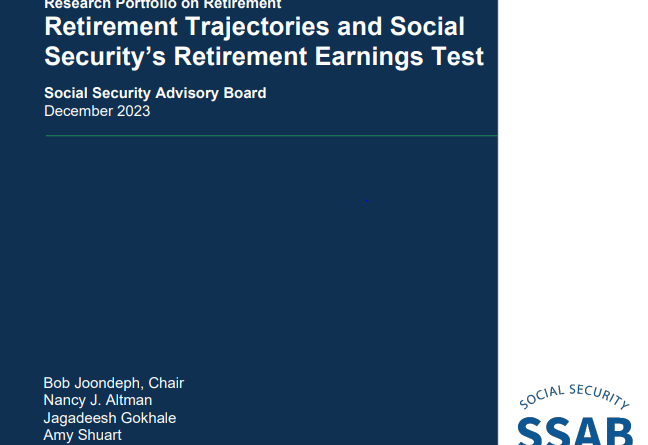Retirement Trajectories and Social Security’s Retirement Earnings Test
By Bob Joondeph Chair, Nancy J. Altman, Jagadeesh Gokhale & Amy Shuart
Social Security’s retirement earnings test (RET) temporarily withholds or reduces the Social Security benefits of people below full retirement age (FRA) who work and earn above a certain threshold while collecting retirement benefits. Those benefits are increased at FRA to account for the months when benefits were withheld or reduced under the RET. The legislative intent of the RET, which has been part of the law since Social Security’s creation in 1935, was to determine whether a worker had left the workforce, since Social Security is designed as an insurance program to partially replace insured workers’ wages that are lost due to old age, disability, or death (for surviving dependents). Studies show that most people do not fully understand how the RET works. While many know that benefits are reduced due to earnings before FRA, most do not understand that this reduction is temporary.
This paper examines the RET in the context of changing work and retirement patterns. We analyze retirement trajectories using micro-data from the Health and Retirement Study (HRS), a nationally representative survey of Americans ages 50 or older and their spouses conducted every two years. We find that over half of the early baby boomer cohort follows a nontraditional retirement path involving either partial retirement or a return to work before permanently leaving the labor force. Half of those who returned to work reported receiving Social Security retirement benefits before returning to work; of these people, 40 percent were below FRA when they returned to work. It is important for older workers and their families to understand the implications of the RET for their work and retirement decisions, given the varied paths people take when permanently leaving the workforce.
The Social Security Administration (SSA) provides several resources to educate the public about the RET. However, this paper demonstrates that not all these resources clearly explain the key features of the RET, and not all the information is conveyed consistently across resources. SSA could improve these materials to communicate the implications of work and retirement more clearly to workers and their families. We conclude by offering recommendations for how SSA can improve these public resources, such as using plain language, ensuring information is consistent and accurate across resources, and improving tools such as the RET calculator. Reminding workers how the RET operates at various points during their careers could help improve awareness of its potential applicability for those who follow nontraditional retirement paths.
Get the report here











